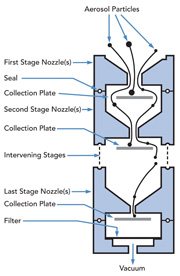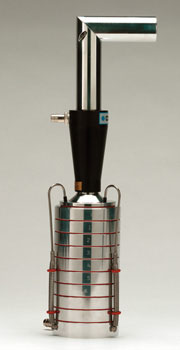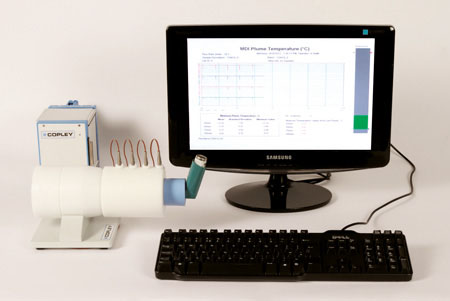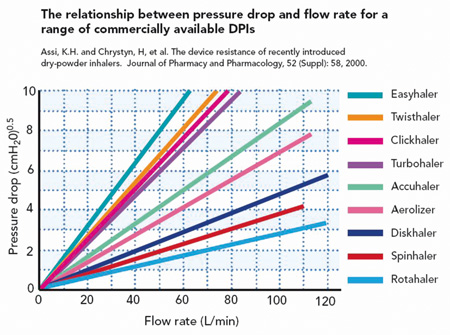Because of their complex mode of delivery, demonstrating bioequivalence of generics for inhaled products can be difficult. Mark Copley, Copley Scientific looks at the surrounding issues and at optimising in vitro testing for the development of generic inhaled products.
As the inhaled product industry matures, and blockbuster drug patents expire, opportunities for generics manufacture increase. Many companies are already capitalising on growing global requirements for effective, inexpensive treatments for chronic obstructive pulmonary disease (COPD) and asthma.
Over the longer term, systemic inhaled therapies, if successful, may become similarly ripe for generic activity. However, the performance of inhaled products, especially dry powder inhalers (DPIs), can be challenging to replicate. The application of appropriate in vitro techniques is crucial to ensure that relevant analytical information is efficiently gathered to support regulatory applications.
New regulatory guidance from the EMA1 provides comprehensive information regarding the issues that need to be addressed to demonstrate bioequivalence in a strictly generic product for European registration. For some, though, the inhaled drug delivery route is perceived as presenting opportunities for the development of so-called ‘supergenerics’ – products that use an approved active pharmaceutical ingredient but offer enhanced therapeutic efficiency. Such products may proceed to market via the FDA 505 (b)(2)2 approval route, in the case of the US, which although streamlined, offers exclusivity of cover for up to three years.3
In vitro testing techniques support the demonstration of bioequivalence, in line with the regulatory guidance, and more broadly minimise the requirement for clinical trials
In vitro testing techniques support the demonstration of bioequivalence, in line with the regulatory guidance, and more broadly minimise the requirement for clinical trials. However, the optimisation of such testing begins with an appropriate understanding of the regulatory climate that surrounds generic inhaled product development.
Guidance on inhaled generics
Conventional generics are prescribed interchangeably with the reference product and must therefore be formulated to deliver closely equivalent clinical efficacy. The latest regulatory guidance for inhaled generics for asthma and COPD, released by the EMA in 2009,1 implies that this aim can be realised by comprehensively demonstrating bioequivalence, potentially through in vitro testing alone.
This is an attractive proposition for generics development since the elimination of additional pharmacokinetic and pharmacodynamic (PK/PD) studies substantially reduces both development costs and time to market. However, the successful application of this strategy relies not only on meeting a range of stringent criteria stated within the regulatory guidance, but also on identifying in vitro tests that robustly characterise those criteria.
Key requirements, in summary, include the need to ensure that:4
- The product contains the same active ingredient, in the same solid state, as the reference product, and that any differences in crystallinity do not affect solubility
- Any qualitative or quantitative change in the excipient does not affect the performance of the product, aerosol particle behaviour, the inhalation behaviour of the patient or the safety profile of the product
- Instructions for use of the product are identical to those of the reference product and that the inhaled volume needed to deliver a sufficient dose of the active is similar in each case (within +/-15%)
- The delivered dose of the product is the same as for the reference product (within +/-15% of labelled claim)
- The inhalation device used has the same resistance to air flow as the reference device (within +/-15%)
Supergenerics
In marked contrast to copycat products, supergenerics are defined as ‘improved therapeutic entities derived from known generics’.5 They are of significant interest to those looking to use the inhaled drug delivery route to develop better-performing formulations to meet defined clinical requirements – to treat paediatric or geriatric patients, for example. Such products clearly present a very different regulatory challenge since here the aim is to demonstrate enhancement rather than equivalence.
At the time of writing the FDA had not released guidance equivalent to the EMA, specifically for the bioequivalence testing of inhaled products. Unlike the stepwise methodology favoured by the EMA, the FDA appears to prefer a ‘weight of evidence’ approach.
Unlike the stepwise methodology favoured by the EMA, the FDA appears to prefer a ‘weight of evidence’ approach
Currently there are three distinct pathways to regulatory approval: 505 (b1) and 505 (b2) for new drug applications (NDAs), and 505 (j) for abbreviated new drug applications (ANDAs). The 505 (b1) pathway is a fully formalised process for a NDA while the 505 (j) route is a streamlined route designed for generics.
The 505 (b2) pathway potentially represents an attractive approval route for supergenerics that is streamlined relative to the (b1) alternative, but that nevertheless offers exclusivity for up to three years. That said, the 505 (b2) remains relatively under utilised, with the most common problem being lack of appropriate data.2
Those seeking to proceed via the 505 (b2) route with an inhaled supergeneric, like those developing a completely new product, need to demonstrate a more comprehensive under-standing of product performance than is afforded by simply showing bioequivalence to an originator.
For inhaled products the correlations between in vitro measurements and in vivo behaviour are not yet secure, making it difficult, if not unfeasible to reliably scope, as oppose to copy, product performance using in vitro data alone. Current, standard in vitro tests are vital for all types of product development but their ongoing refinement towards better in vivo representation, as covered in reference 6, is a helpful trend that could in the long term prove especially relevant for supergenerics.
In vitro test methods
Referring back to the criteria listed in the EMA guideline, it is clear that one element of testing is analysis of the constituent ingredients, to determine the chemical assay of the active ingredient, for example, or its morphological form. However, for inhaled products, drug delivery performance is ultimately defined by the device and formulation, in combination, which is why the full demonstration of bioequivalence relies on a number of in vitro techniques applied to the complete product.
Delivered dose uniformity (DDU)
Delivered dose is one of the central parameters used to define inhaled product performance. It is measured by firing the test device into a sampling apparatus containing a filter, subsequent analysis of the captured dose, typically by HPLC, determining the amount of active pharmaceutical ingredient (API) present. Overall weight is also sometimes measured.
DDU testing directly confirms that the amount of API delivered is comparable to the label claim of the reference product
From the point of view of demonstrating bioequivalence in line with the EMA guidance, DDU testing directly confirms that the amount of API delivered is comparable to the label claim of the reference product, to within the +/-15% acceptable tolerance. It also provides supporting evidence that the chosen excipient does not influence the performance of the product and that the same inhalation volume is required to obtain a sufficient quantity of active.
During DDU testing the air flow rate drawn through the sampling apparatus is set on the basis of simulating the inhalation flow rate applied during use. The vast majority of metered dose inhalers (MDIs) are propellant-driven and this makes drug delivery largely independent of the air flow rate applied by the user. For MDIs the air flow rate used is therefore set at a nominal 28.3L/min (1 scfm), a figure that derives from the calibrated performance data for cascade impactors.
In contrast, with the majority of dry powder inhalers (DPIs), the inhalation manoeuvre of the patient provides the only motive force for drug delivery and can have a significant impact on: aerosolisation of the dose; emptying of the device; and the amount of drug delivered.

Figure 2: Multistage cascade impactors accelerate particles progressively through a number of stages to separate the dose into sized fractions on the basis of particle inertia. (Adapted from USP Chapter <601>)
As a result, the pharmacopoeias recommend that the test flow rate applied is carefully determined for each individual product, based on an assumption that a typical patient will apply a pressure drop of 4kPa across the device during inhalation. The flow rate that this induces across the inhaler is a function of its internal resistance and is measured using a standard test set-up (Fig. 1).
This approach results in high resistance DPIs being tested at relatively low flow rates, while low resistance devices require a high flow rate, up to an upper limit of 100L/min. The duration of the test is set on the basis of the total air volume typically inhaled in one breath by an adult patient – the pharmacopoeias recommend 4L and the FDA 2L, but other volumes could be used to show bioequivalence.
Nebuliser testing is similarly complicated by the mode of operation of the product, since the amount of drug delivered is a function of the user’s tidal breathing pattern and duration of use. New test methods7,8 define standardised flow conditions for delivered dose testing, to reflect an adult breathing pattern: 500mL tidal volume; sinusoidal waveform; 15 cycles per minute; 1-to-1 inhalation/exhalation ratio. However, they also indicate the need to use different breathing profiles to assess products for neonate, infant and child patients.
This relatively recent development is a prime example of the refinement of test methods to give more relevant data and exemplifies the types of testing that might be particularly useful in the development of supergenerics that offer enhanced therapeutic efficiency for discrete patient groups.
Finally, for all multi-dose inhalers it is essential to verify dose uniformity across the life of the product. The USP and Ph.Eur. recommend that the first three, middle four and final three doses are assayed for a multi-dose MDI or DPI with a labelled number of doses and specify the number of devices that should be tested.
Aerodynamic particle size distribution (APSD)
The APSD of all inhaled products is measured to infer information about likely in vivo deposition behaviour, which is influenced by delivered particle size. Generally speaking, particles in the 1–5µm size range will tend to deposit in the pulmonary region, with larger particles tending to remain in the mouth and throat, and finer ones likely to be expelled during exhalation. Multistage cascade impaction is the technique used for APSD measurement because of its unique relevance. Unlike other techniques that span the sub 10µm fraction of interest, cascade impaction generates aerodynamic particle size data, and for the API alone, rather than for the whole formulation.
Unlike other techniques that span the sub 10µm fraction of interest, cascade impaction generates aerodynamic particle size data, and for the API alone, rather than for the whole formulation
With respect to demonstrating bio-equivalence, according to the EMA guidance, cascade impaction data can be used to verify that the inhalation volume needed to obtain a sufficient dose is equivalent to a reference product, but perhaps most importantly it can be used to investigate thoroughly the delivered particle size profile of the generic product and, by extension, the likelihood of closely similar in vivo deposition.
Multistage cascade impactors divide a dose into size fractions on the basis of particle inertia to produce a series of samples for subsequent analysis, typically by HPLC. Figure 2 illustrates the basic principles of operation, which are described in greater detail in reference 9. The parameters that determine the size of particles captured on each stage, the stage cut-off diameter, are: mechanical dimensions (principally nozzle size and the distance between the stage and the collection surface) and the volumetric flow rate of air through the instrument. The multistage cascade impactors most widely used for inhaled product development, the Andersen Cascade Impactor (ACI) and the Next Generation Impactor (NGI), always have at least five stages with cut-off diameters in the sub 5µm region, across the required flow rate range, and therefore offer high resolution in the area of most interest for pulmonary deposition.
As with DDU testing, the test conditions, and most specifically the air flow rate applied during testing, must be representative of product use. Test flow rates analogous to those applied during DDU testing are therefore adopted. However, cascade impactors require a constant flow rate, making it unfeasible to apply realistic breathing patterns. All inhaled products are, therefore, tested at a constant flow rate, with nebulisers measured at a flow of 15L/min, which is deemed representative of the mid-tidal flow rate of a typical adult user.
This is an area of interest in the refinement of testing, especially for DPIs, with mixing inlets being used to decouple flow across the device and through the impactor to investigate product performance in greater detail. Such an approach enables the application of a more representative inhalation profile through the device, normally by way of a breath simulator, within the constraint of ensuring constant flow rate through the impactor and within the range of calibrated performance.

Figure 3: Using a mixing inlet decouples flow through the impactor and device, allowing the application of more representative inhalation profiles during testing, within the constraint of ensuring a constant flow rate through the impactor
Multistage cascade impactor data are often grouped to generate metrics such as fine particle dose (FPD), the sub 5µm fraction, that because of its size might be expected to deposit in the lungs. To demonstrate bioequivalence EMA guidance recommends the stage-by-stage comparison of data or the comparison of a minimum of four groupings justified with reference to inferred deposition site within the lung.
Three batches of both the reference product and the generic should be tested and maximum allowable differences calculated to form the basis of a decision justifying bioequivalence.10 This is arguably one of the most demanding steps in demonstrating bioequivalence since variability in cascade impaction is often considerable. Further information on how to improve the accuracy and precision of this technique is provided in reference 9, which addresses issues of best practice.
It is important to recognise that the groupings used for the comparison of APSD need to span the entire range captured by the cascade impactor since both fine and coarse fractions are important in defining safety and efficacy; coarser material potentially entering the body via the gastrointestinal route. Furthermore, for products such as DPIs that exhibit flow rate dependent performance, testing must be carried out at a range of different air flow rates to ensure that performance is accurately scoped for all potential users.
Measuring the cold Freon effect
The cold Freon effect is the inadvertent reaction to the chilling sensation that hits the back of the throat following actuation of a propellant-driven MDI. Caused by impaction of the delivered dose and the rapid evaporation of any remaining propellant, it strongly influences the efficiency of drug delivery and is specifically mentioned in the EMA guidance:10 ‘Any qualitative and/or quantitative differences in excipients should not influence the performance of the product… and/or the inhalation behaviour of the patient (e.g. particle size distribution affecting mouth/ throat feel or “cold Freon” effect).’
This inclusion is because the cold Freon effect can cause the patient to abort or unsuccessfully complete the inhalation manoeuvre, compromising delivery of the drug. The reformulation of MDIs with propellants such as HFA 134a, as a result of the banning of CFCs in the Montreal Protocol, clearly has substantial potential to affect this phenomenon and has provided a stimulus to the development of reliable measurement methods.

Figure 4: Measuring the impaction force of the plume and its temperature as a function of distance from the mouthpiece, enables direct comparison of the cold Freon effect to demonstrate bioequivalence
One extensive study of measurement of the cold Freon effect11 has led to the introduction of the Plume Temperature Tester Model PTT 1000 (Copley Scientific), which measures temperature as a function of distance from the mouthpiece. With a geometry similar to the USP induction port this instrument captures temperature data at 25, 50, 75 and 100mm from the mouthpiece to produce a temperature profile for the plume.
Used in combination with measurements of the impaction force of the plume, gathered with an instrument such as the Spray Force Tester Model SFT 1000 (Copley Scientific),12 such data fully quantify the cold Freon to support the demonstration of equivalence. However, beyond this, such instruments support the manipulation of the formulation and delivery device, and the use of add-on devices such as spacers and valved holding chambers, to ensure softer, warmer plumes that enhance therapeutic efficiency by reducing usage errors.
Device resistance
Device internal resistance is specifically mentioned in the EMA guidance as being an important issue for copycat DPIs. Figure 5 shows how the internal resistance of DPIs affects the air flow rate drawn through them during inhalation by the patient. As noted, it is this air flow rate that drives the aerosolisation process that ensures successful drug delivery, which is why the parameter is of such importance when comparing performance characteristics. Furthermore, resistance may also have an impact on the user experience, as well as resulting in a different type of inhalation manoeuvre, which may be of significance if switching between the reference product and generic equivalent.

Figure 5: The internal resistance of DPIs varies considerably from device to device and this directly affects the air flow rate that will be drawn through the product during use
Figure 1 shows the test set-up used to determine the flow rate that results in a pressure drop of 4kPa across the device, for both DDU and APSD measurements. It is easy to see that with a little manipulation this set-up can be used to generate the corresponding data needed to demonstrate equivalent internal resistance, a test that involves applying a known flow rate through the device and measuring the resulting pressure drop across it. Measuring internal resistance can thus be relatively straightforward with appropriate equipment of the necessary precision but it is important to make measurements across a range of flow rates to ensure complete characterisation of the device.
In conclusion, the efficient development of inhaled generics demands the effective leveraging of all applicable in vitro test methods, to demonstrate bioequivalence. This review provides an introduction to the techniques of most relevance, showing how they provide the data needed to support a regulatory submission in accordance with the latest guidance from the EMA.
For those with the greater ambition of developing supergenerics, in vitro testing also has much to offer, especially as test methods are refined towards better in vivo representation. In the future these developments will support the fuller exploitation of the pulmonary delivery route to deliver optimally to clinical requirements.
References
1. EMA “Guideline on the requirements for clinical documentation for orally inhaled products (OIP) including the requirements for demonstration of therapeutic equivalence between two inhaled products for use in the treatment of asthma and chronic obstructive pulmonary disease (COPD) in adults and for use in the treatment of asthma in children and adolescents” Issued Jan 2009 www.ema.europa.eu/docs/en_GB/document_library/Scientific_guideline/2009/09/WC500003504.pdf
2. V. Shah “Regulatory framework enhanced therapeutic entities” Presentation delivered at 2nd open forum on pharmaceutics and biopharmaceutics. Istanbul, Turkey, April 26/27 2012.
3. K. Wekselman et al, RAJ Pharma Feb 2010
4. C. Hippchen “Pharmacopoeial requirements for dry powder inhalation systems” Presentation at 2nd open forum on pharmaceutics and biopharmaceutics. Istanbul, Turkey, April 26/27 2012.
5. S. Stegemann et al. European J of Pharm Sci. 44, 447–454, 2011
6. M. Copley. OnDrugDelivery 2011, 12, 8–12
7. Ph. Eur 2.9.44
8. USP 1601
9. M. Copley, Drug Delivery Technology 2010, 6, 29–33
10. A. Fuglsang “Regulatory issues and challenges relating to pulmonary products” Presentation at 2nd Open Forum on Pharmaceutics and Biopharmaceutics. Istanbul, Turkey, Apr 26/27 2012.
11. G. Brambilla et al Int. J. of Pharmaceutics 2011, 405, (1–2), 9–15 doi:10.1016/j.ijpharm.2010.11.037
12. J. Aerosol Med. Pulm. Drug Deliv. 2012 25 (2), 104–9. doi: 10.1089/jamp. 2011.0891. Epub 2011 Dec 22.




